Comparing and ordering fractions worksheets for 4th graders
Fractions can be a challenging topic for many students. But fear not, because this article is enriched with fun comparing and ordering fractions worksheets for 4th graders to enjoy practicing. In this article, you will find various resources to make comparing and ordering fractions fun and easy to master!
-
However, you will find a selection comparing and ordering fractions worksheets from Mathskills4kids.com that you can download and print for your child or classroom. These worksheets are packed with colorful visuals, interactive activities, and clear explanations that break down the concepts in a way that is easy to understand.
Plus, they're designed to be both challenging and rewarding so students can feel confident in their math skills.
With these worksheets, 4th-grade math learning will be an enjoyable experience for students and teachers alike!
Importance of comparing and ordering fractions for 4th graders
Before we dive into the worksheets, let's take a moment to understand why comparing and ordering fractions is such an important concept for 4th graders. Fractions are a fundamental part of math and are used in many different areas, including science, engineering, and finance.
In 4th grade, students will be introduced to fractions more meaningfully than in previous grades, and they'll be expected to perform operations with fractions, such as adding, subtracting, multiplying, and dividing.
One of the first steps in working with fractions is understanding how to compare and order them. This involves understanding the relationship between fractions and their size and the use of common denominators. Mastering this concept will give students a solid foundation for working with fractions in more complex ways.
-
BROWSE THE WEBSITE
-
DOWNLOAD FREE WORKSHEETS
-
-
4th GRADE MATH TOPICS
- Number sense
- Addition
- Subtraction
- Multiplication
- Division
- Mixed operations
- Variable expressions
- Functions
- Coordinate plane
- Data and graphs
- Logical reasoning
- Patterns and sequences
- Money math
- Units measurement
- Telling time
- Equivalent fractions
- Compare & order fractions
- Add & subtract fractions with like denominators
- Add & subtract fractions with unlike denominators
- Multiply fractions
- Decimals
- Add and subtract decimals
- Probabilities and statistics
- 2D shapes
- Triangles and quadrilaterals
- Symmetry
- Angles
- 3D shapes
- Geometric measurement
-
-
Compare fractions with like numerators and denominators
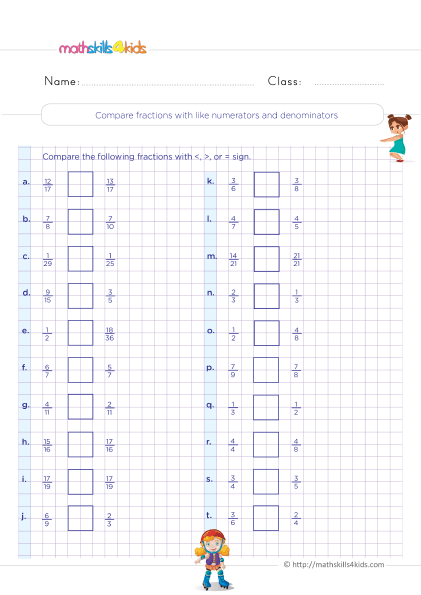 Print it...
Print it...
-
Compare fractions with like numerators or denominators
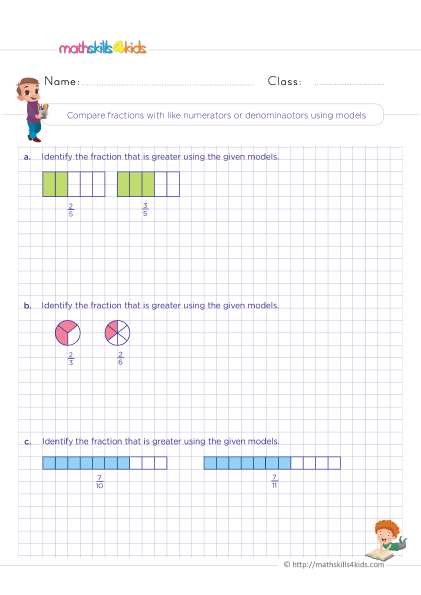 Print it...
Print it...
-
Graph and compare fractions with like numerators and denominators
 Print it...
Print it...
-
Order fractions with like numerators or denominators
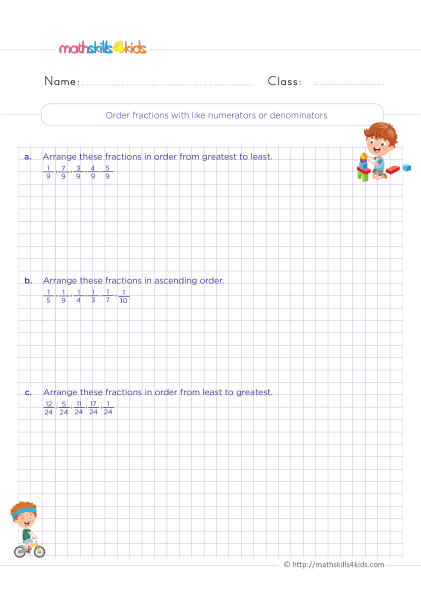 Print it...
Print it...
-
How do you solve comparing fractions?
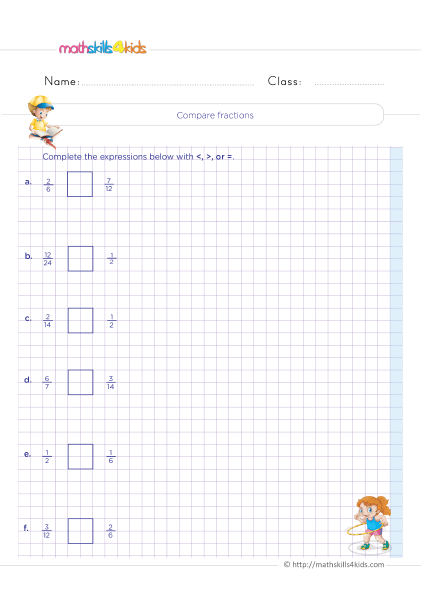 Print it...
Print it...
-
Real life situation:
compare fractions in recipes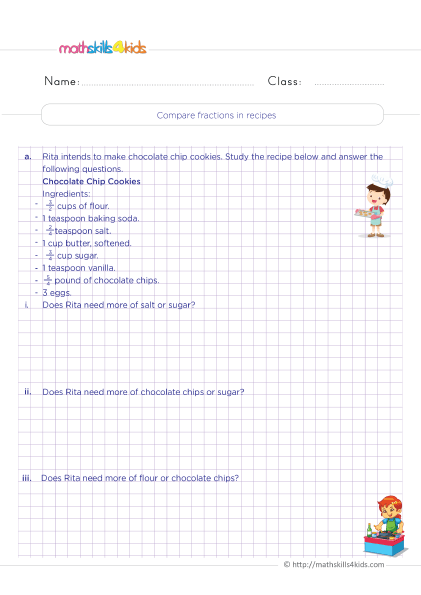 Print it...
Print it...
-
Compare fractions with like numerators and denominators
-
Buying is supporting us!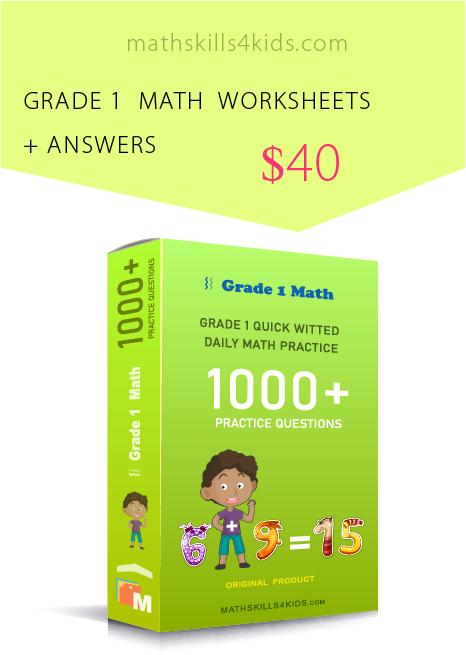
Buy Now...
-
-
Common core state standards for comparing and ordering fractions
The Common Core State Standards provide guidelines for what students should know and be able to do at each grade level. For 4th graders, the standards include focusing on comparing and ordering fractions. Specifically, students should be able to:
- Explain why a fraction a/b is equivalent to a fraction (n × a)/(n × b) by using visual fraction models, with attention to how the number and size of the parts differ even though the two fractions are the same size. Use this principle to recognize and generate equivalent fractions.
- Compare two fractions with different numerators and different denominators, e.g., by creating common denominators or numerators or by comparing to a benchmark fraction such as 1/2. Recognize that comparisons are valid only when the two fractions refer to the same whole. Record the results of comparisons with symbols >, =, or, and justify the conclusions, e.g., using a visual fraction model.
- Order fractions from least to greatest by using common denominators.
These standards provide a clear roadmap for what students should be able to do, and the worksheets we will explore are designed to help students meet these standards.
-
Tips for teaching comparing and ordering fractions to 4th Graders
Before we jump into the worksheets themselves, let's take a moment to talk about some tips for teaching comparing and ordering fractions to 4th graders. These tips will help ensure that your students understand the concepts and feel confident in their abilities.
- Use visuals: Fractions can be abstract, so visual aids can help make the concepts more concrete. Please encourage students to draw pictures or use manipulatives to help them understand the relationship between fractions and their size.
- Practice, practice, practice: Like with any skill, practice is key to mastering comparing and ordering fractions. Ensure to provide plenty of opportunities for students to practice in class and as homework.
- Emphasize the importance of common denominators: Understanding how to find common denominators is essential to comparing and ordering fractions. Make sure to emphasize this point and provide plenty of practice problems that require finding common denominators.
- Use real-world examples: Help students see the relevance of fractions by using real-world examples. For example, you could talk about how recipes often require fractions or how fractions are used in construction.
By following these tips, you can help ensure that your students understand comparing and ordering fractions.
-
Engaging comparing and ordering fractions worksheets for 4th Graders
Now that we've covered why comparing and ordering fractions is important and some tips for teaching it, let's dive into the worksheets themselves. These engaging Mathskills4kids’ comparing and ordering fractions worksheets for 4th Graders are designed to be engaging and fun while providing a solid foundation for understanding, comparing, and ordering fractions.
Here are some of the skills children will develop using our worksheets:
- Comparing fractions with like denominators or numerators
- Graph and compare fractions with like denominators and numerators
- Comparing fractions using models
- Comparing fractions using benchmarks
- Comparing fractions in recipes
- Graphing and ordering fractions on a number line
- Ordering fractions with like denominators and numerators
- Finding smaller or larger fractions
-
How to track progress and assess understanding of comparing and ordering fractions
As students work through the worksheets and games, tracking their progress and assessing their understanding of comparing and ordering fractions is important. One way to do this is through formative assessments, such as quizzes or exit tickets. These assessments can provide valuable feedback on what students have mastered and what they still need to work on.
Another way to assess student understanding is through observation. By watching students work through problems and asking them to explain their thinking, you can get a sense of their understanding of the concepts.
Bonus: More resources to reinforce 4th grade comparing and ordering fractions
In addition to the games, comparing and ordering fractions worksheets for 4th Graders we've already discussed, there are also a variety of other online resources that can reinforce 4th-grade math and fractions learning easy and fun.
Here are some of the pages that you can find:
- Fractions Activity Cards – equivalence, compare, complete one, addition (print and digital) | Mathcurious
Comparing and Ordering Fractions Task Cards: These 32 task cards are perfect for practicing comparing and ordering fractions with different denominators. They include various question types, such as using fraction models, number lines, equivalent fractions, and comparing fractions to benchmarks. You can use them for math centers, games, scooting, or independent work. They also have a recording sheet and an answer key for easy checking.
- Comparing and Ordering fractions - Lesson Plan- Math Worksheets (mathfunworksheets.com)
Comparing and Ordering Fractions Worksheets: Sometimes, you need some good old-fashioned worksheets to assess your students' understanding of comparing and ordering fractions. These 10 worksheets are aligned with the Common Core standards and include various question types, such as shading fractions, writing fractions in words, using symbols (<, >, =), and ordering fractions from least to greatest or greatest to least. They also have answer keys for easy grading.
- Put Fractions in Order Up to Twentieths - Grade 4 - Practice with Math Games
Comparing and Ordering Fractions Games: Who doesn't love playing games while learning math? These 4 games are designed to make comparing and ordering fractions fun and exciting for your students. They include a fraction war game, a fraction bingo game, a fraction matching game, and a fraction sorting game. You can use them for whole class, small group, or partner activities. They are also easy to prepare and play.
- (64) Comparing Fractions for Kids | Easy Math Lessons - YouTube
Comparing and Ordering Fractions Videos: Sometimes, a video can explain a concept better than words. These 4 videos are short and engaging, and they teach your students how to compare and order fractions using different strategies. They include using fraction models, number lines, cross-multiplication, and common denominators. You can use them as an introduction, a review, or a reinforcement of the skill.
-
Thank you for sharing the links of MathSkills4Kids.com with your loved ones. Your choice is greatly appreciated.
Conclusion
We hope you find these resources helpful and useful for your 4th-grade math instruction. Comparing and ordering fractions is a crucial skill that your students need to master before moving on to more complex fraction operations. With these resources, you can ensure they have plenty of practice and fun along the way!
Comparing and ordering fractions can be challenging for 4th graders, but with the right resources and teaching strategies, it can be made easy and even fun. The Mathskills4kids comparing and ordering fractions worksheets for 4th graders and games explored in this article are designed to provide students with a solid foundation in comparing and ordering fractions while keeping them engaged and motivated.
Following the teaching tips and using these resources, comparing and ordering fractions can help your students feel confident and successful in 4th-grade math.
